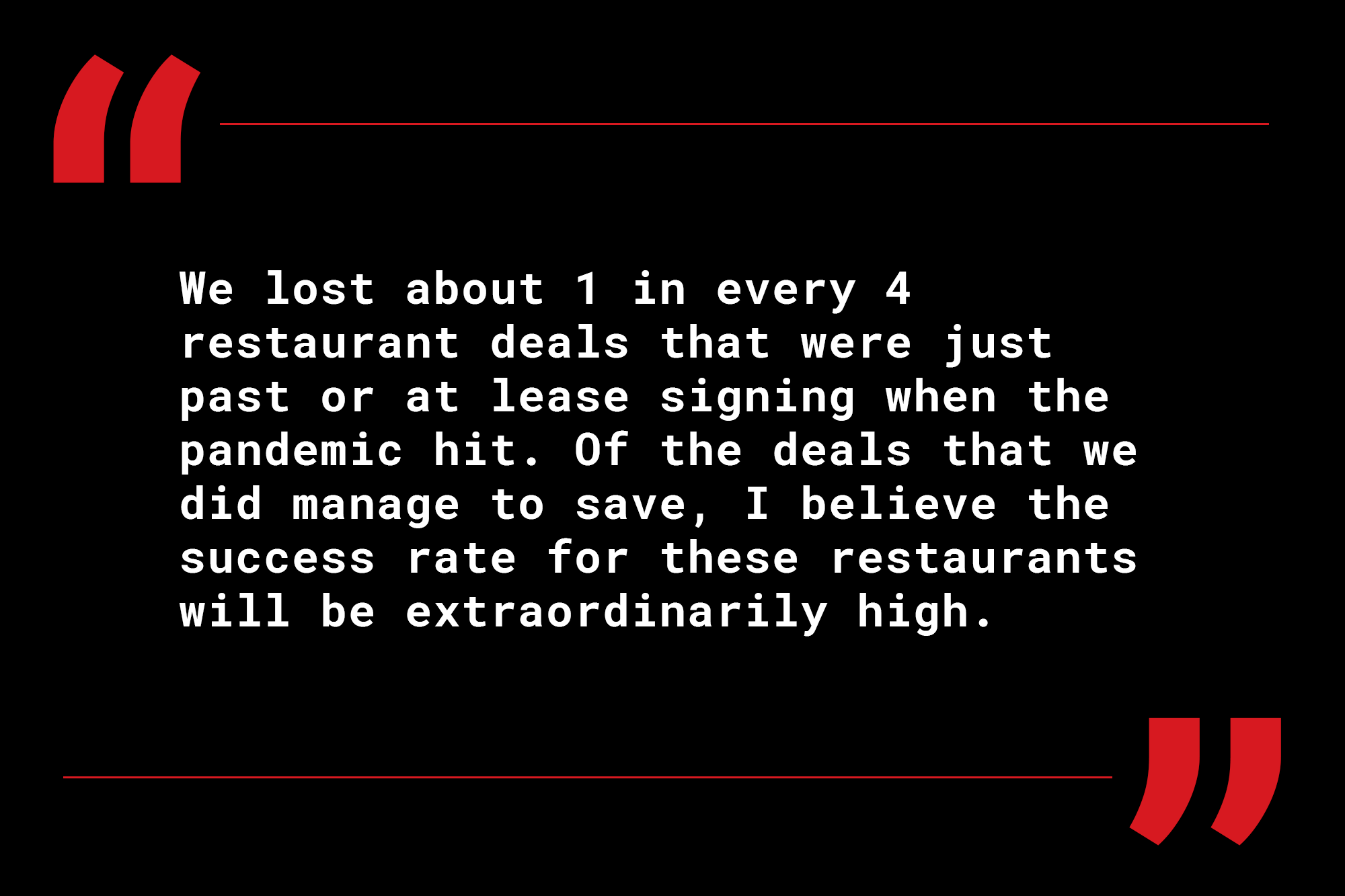Update #17: Happy New Year; and your favorite subject, Restaurants
Dear Clients & Colleagues,
Three weeks into 2021 and we are still here; learning, iterating, surviving. 2020 was a hard and intense year for us at Graffito, but at the same time it was a year filled with a lot relationship strengthening and a reset of our strategic goals. Our numbers for 2020 tell a story of severe disruption to projects, transactions, and cash-flow due to COVID-19, but we closed out 2020 with a larger staff than we had at the same time in 2019, better tools than ever before to solve the challenges ahead, and far more comfort with our ability to handle the relentless uncertainty that lies ahead.
All of you receiving this email have been through significant business disruption of one kind or another in 2020. And a lot of you, like us, have been through a corresponding series of pivots and adjustments. It has been a great pleasure to share with you all what’s going on at Graffito these past 10+ months through these updates; and similarly to share what we are seeing out there in the world of retail real estate, restaurant development, place management, and neighborhood building. Your responses to these updates (and subsequent conversations I’ve had with many of you) were a highlight for me, and feedback from you re: our blog posts and podcast was instructive and valuable for the whole Graffito team. Of all the feedback we have garnered from you all and others, there’s one specific area that generated the most discussion: restaurants — the fate of them; the viability of particular concepts; and mostly questions about how to structure deals moving forward.
All of us at Graffito have have spent time writing about restaurants over the past 10 months — from Corey’s series on restaurant retrofits, to Gustavo’s writing on outdoor dining, Brooke’s notes on restaurant spacial distancing signage, and Drew’s piece on restaurant websites — we have all put out a lot of content that leverages our experience working with restaurants. Angela, Dave and I that have spent the most time writing about, working with, and talking to you all about the future of restaurant leasing. Our perspective is informed by work with dozens of landlord clients, and also a small handful of restaurant clients.
As many of you know, when Graffito was ramping-up its brokerage business ten years ago we had a razor-sharp focus on landowner/developer advisory work. Over the years though we’ve softened our position on representing tenants and today work with a small handful of restaurants, namely Tatte Bakery & Cafe, Clover Food Lab, Life Alive Organic Cafe, and Revival Cafe + Kitchen. We believe these are four of the most interesting locally based fast order concepts in the market, have deep connections to each of these business’s founders/owners, and have come to appreciate that doing work for tenants makes us a better business. Working with this group of four in 2020 has exposed us to dozens of deals on top of what we have been doing with our landlord clients. And, most importantly, working on the tenant-side has helped further our understanding re: non-transactional issues touching the restaurant industry, many of which we’ve hit on via our blog and podcast — things like staffing, supply chain, online ordering platforms, the economics and cost of hibernating, PPP related challenges, etc.
Given all of the above, it feels appropriate that this first note of 2021 to you focuses on restaurants. Specifically, the present and future state of restaurant deal making. And I think the best way to organize this report-out is by breaking it into the following three sections based on opening (or expected opening) timing:
I. Pre-2020 openings. Deals that were complete (and restaurants open) prior to the onset of the pandemic.
II. 2020 openings.Transactions that were completed before the pandemic and scheduled for opening in 2020. These have been some of the hairiest deals to work though (and save) and have brought a host of challenges, especially those that were midstream in buildout when the pandemic hit.
III. New Deals. Any deal that was signed after the onset of the pandemic.
I. Pre-2020 Openings – Existing Restaurant Deals
We are all spending a lot of time talking about the future of the restaurant deal, but the stark reality is that all of us working for or sitting in the landowner chair are going to spend far more time in 2021 working on existing deals. Short-term restructuring has taken up an incredible amount of time these past ten months for both landlords and tenants; and as I step back and look at the state of the market right now there are very few deals that have gone untouched. In fact, I would suggest that there are few restaurants that have not, in some way, had to amend a lease, even if it was only having to do with a continuous operating clause or operating hours.
Few restaurants in the urban context, particularly full-service restaurants, will look the same in 2021 as they did in 2019. Even the seemingly most insignificant changes, such as consents needed for new take-out signage or landlord approvals for menu/concept changes, come with landlord/tenant negotiations and potentially also the need for lease amendments. And the significant changes to leases — working out revised economic terms and revisiting restrictive covenants — have absorbed a tremendous amount of our time.
The good news as related to existing deals is that, for many restaurateurs, if you’ve made it this far help is on the way: PPP #2 is coming; many states (MA included) are finally acting to support the restaurant industry through legislative action; we have a new administration in Washington D.C. that is taking science and non-Wall Street economic indicators seriously; and the expected vaccine rollout combined with the return of outdoor dining later this quarter and into Q2 will bring desperately needed relief. So, there is reason to be hopeful. Though as Angela put it so well back in April, we need to keep our eyes wide open in the months and years ahead because “… similar to what traditional retailers went through during the surge of the e-commerce world, full-service restaurants will have to become multi-dimensional…”. What exactly it means to be multidimensional for a restaurant is still a bit TBD, but as we all continue to work through and revise our existing leases we should be eyes wide open to the coming of things such as restaurant subscriptions and memberships, a further shift away from fine dining, and the stickiness of pandemic-spurred innovations/collaborations like Toast Drop in Kendall Square.
Consider this: what happens when the existing restaurant in your project that still has six years left on their lease tells you they want to change their concept from a classic neighborhood bistro with table service only to a fast casual concept? Oh, and they are also launching a subscription model in cooperation with three other restaurants at different locations but under common ownership (with different LLCs, of course). Said meal subscription model is new, the lease didn’t anticipate it, and it’s going to make up over 30% of the restaurant’s revenue moving forward, all of which is potentially excluded from the current definition of gross rent for the purposes of calculating percentage rent in the lease. And lastly, they need 5 exclusive spots for temporary parking in front of the Premises…
These are the kind of issues we are all going to be dealing with in 2021 and beyond on existing restaurant deals. It may seem far-fetched right now, but it’s not, and those of you deep in the restaurant world know it’s here already; and here to stay.
II. 2020 Openings – Signed Pre-Pandemic, Schedule to Open in 2020
Everything was damn weird in 2020, but this group of deals was the weirdest, especially those deals that were mid-buildout when the pandemic hit. Hard stuff. We dealt with projects across Greater Boston in this category, in our work in neighborhoods such as Cambridge Crossing, Malden Center, Newtonville, South Boston, Central Square, The Seaport, and Kendall Square. And that’s just on the landlord-side. With our tenant clients we dealt with projects at The Prudential Center, on Newbury Street, Downtown Crossing, Charlestown and, with Tatte, in Washington DC.
For this group of deals there was simply no unifying script. But there were constants:
- Landlord pressure to open sooner without additional consideration (free rent, additional TI, etc) didn’t move the needle;
- Rent Commencement Dates (and other related milestones in the Lease) had to be thrown out the window;
- Construction Costs didn’t come down… they went up; and
- Where there was a committed tenant there was most often a willing Landlord.
But as we learned on more than a few occasions, we (understandably) weren’t always dealing with committed operators on our projects in 2020. We lost about 1 in every 4 restaurant deals that were just past or at lease signing when the pandemic hit. Of the deals that we did manage to save, I believe the success rate for these restaurants will be extraordinarily high. This is largely due to the intense landlord/tenant collaboration that it took to salvage these projects. And it’s the same sort of collaboration, transparency, and energy it took on these deals that it will take to get the restaurant deal of the future done…
III. New Deals – Leases Signed After Pandemic Onset
In Update #7 (April 28, 2020) I wrote:
We expect the restaurant transaction of the future will require more landlord investment, come with less guaranteed rent, and be structured more as partnerships than as a traditional landlord-tenant relationship. And just as with street trees and lobbies, some landlords will invest millions into these pieces of infrastructure, while others simply won’t have the means or the desire to do so. But regardless, something has to give, because pre-virus things were ugly. And post-virus things will be worse; far worse.
The above is right in many circumstances, such as with full-service restaurants in the mixed-use context, but it’s certainly not universal. Sure, the downward pressure on retail rents is impossible to deny, but there is still limited supply of true “A” retail space and there are distinct differences in the way full-service, fast casual, and fast-food restaurants behave.
Well located retail space in the urban, suburban and rural context will remain in high-demand. A+ corners will still demand A+ rent. It’s the B and C retail locations that really concern me. This is where we will experience intense rental rate resets and vacancy; and a lot repurposing to other non-retail active uses. In terms that many of you will appreciate, that retail project that was tough in 2018/19 — the one where you were stretching underwriting as far as you could based on comps that weren’t really true comps — is in trouble. Many landlords that are resistant to approaching restaurant deals in a way as detailed in the quote above will need to drop their desire to have a full-service restaurant in their project. But I stress “full-service”, as things will be different with fast casual and fast-food operations.
Certain fast casual and fast-food concepts aren’t just surviving right now, some of them are thriving. Particularly those that pre-pandemic had strong online ordering platforms, weren’t located exclusively in commercial business districts, and had more than just a lunch business. These casual and fast-food concepts (collectively “fast order”) will continue to expand and they will absorb more and more dollars that pre-pandemic were spent at full-service restaurants. But these fast order concepts require less SF and have different interior and exterior infrastructure needs — so we need to rethink many of our projects with this in mind. In fact, we are going through this with a project right now, wherein we have a great fast order concept that wants 2500 SF of an approx.. 4,000 SF space that is hard to demise (it’s deep and relatively narrow space). But this particular fast order user needs the whole storefront, a connection to back of house for loading and trash, and parking needs that make the remainder of the space, once demised, really hard to lease. The easy solution would be to work out a deal to give the 2,500 SF user the whole space, but they don’t need 4,000 SF and whether they have 2,500 SF or 4,000 SF revenue will be the same, and thus the tenant won’t pay more rent for the bigger space… So what do we to with a leftover 1,000 – 1,500 SF space that lacks a great storefront, has limited signage options, and even if in an “A” project isn’t in an “A” retail location? This is a question a lot of us are asking today on our projects; and it’s the sort of question we’ll be asking a lot in the future…
In closing, restaurants aren’t going anywhere, but there will be less of them and they’ll be different over the next decade than has been the case for the last. Remember, it was just a few years ago that we were all talking about the astounding reality that Americans, for the first time ever, were spending more money eating out at restaurants than at grocery stores. This was a massive shift in consumer behavior that occurred after the last recession, but this is no longer. And it’s hard to imagine that we get back to this point any time soon, if ever.
As noted by Derek Thompson in his widely read and circulated expose in the Atlantic back in April, The Pandemic Will Change American Retail Forever: “Over the past few decades, U.S. restaurants have become world class. Dining out in America has become a kind of art form… But COVID-19 could bring this golden age to an abrupt close.”
I still think US restaurants will be world class. But I do believe we will have far less world class restaurants moving forward; or, rather, maybe what it means to be “world class” is just changing?
As restaurants change so too will the real estate that houses them. And we all need to be quick to adjust. Those of us that dig in and resist the shifts coming will be most adversely affected. Those of us that lean into understanding the shifts, as hard as this may be, will be best equipped to benefit from them. And we’ll be here along the way to try and shed some light on all of what we are seeing out there, because if we made it through 2020 intact, we can sure as hell make it through 2021.
Happy new year,
/Jesse




